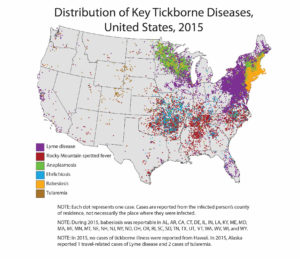The CDC estimates that more than 300,000 people will get sick with lyme every year. The number of cases being reported to the CDC is steadily on the rise. Here is what you need to know to remove ticks properly if you are bitten. Removing ticks properly helps reduce the chances of them infecting you with a number of tick borne illnesses including lyme.

If you are bit by a tick:
- Don’t panic! Please do not rush to remove a tick and forget the proper way to remove it because you are panicking. You might be grossed out, but it is really important to follow the right steps in order to minimize the likelihood that the tick will spread lyme or another tick borne illness to you.
- Do NOT irritate the tick – if you make it angry by applying essential oils, soap, burning a match on it or using vaseline or other irritating method on it, it is more likely to regurgitate its infectious contents into your body and make you sick.
- A fine pointed tweezers is a safe way to remove a tick – very carefully (without twisting), use the tweezers to grasp the tick as close to where it meets the skin as you can. Pull in the opposite direction from which it has embedded itself.
Here is a great video showing the safest way to remove a tick: (please note that ANY tick can transmit lyme or another tick borne illness)
- After safely removing the tick, please save it in a ziplock bag or other container to test it for tick borne infections. The tick does not need to stay alive for it to be tested for pathogens. If you aren’t prepared to have it tested immediately, label the container and save it so it can still be tested later.
- After the tick has been removed, it is a good idea to wipe the bite area with alcohol and apply something topically to help treat the area in case a pathogen has been transmitted. Anti-infection essential oil based products or andrographis tincture are both popular choices.
- The longer a tick has been attached, the higher the risk it has transmitted a tick borne infection to you. It is possible that you have been infected even if the tick was attached less than 24 hours.
- Monitor your health. Tests for lyme and other tick borne infections aren’t very reliable, so if you suspect you are ill from a tick bite, follow up on it and advocate for yourself. Most healthcare practitioners have only very basic understanding of lyme and related infections and it is common that you will need to search out specialized help to get a proper diagnosis and treatment. Besides lyme, you may need to be tested and treated for babesia, anaplasmosis, ehrlichia, bartonella, RMSF (Rock Mountain Spotted Fever) and other tick borne infections. It is important to receive prompt treatment with any tick borne infection.
Helpful Products and additional instructional videos:
- “Tick Ease” tweezers: Great tweezers designed specifically to remove ticks from humans and their pets
- “Tick key” device to keep on your key chain so you are always prepared
- A great visual demonstration to help understand why irritating the tick increases the chances of transmitting disease causing pathogens into your body:
Further reading on lyme disease and related infections:
Tick Testing:


